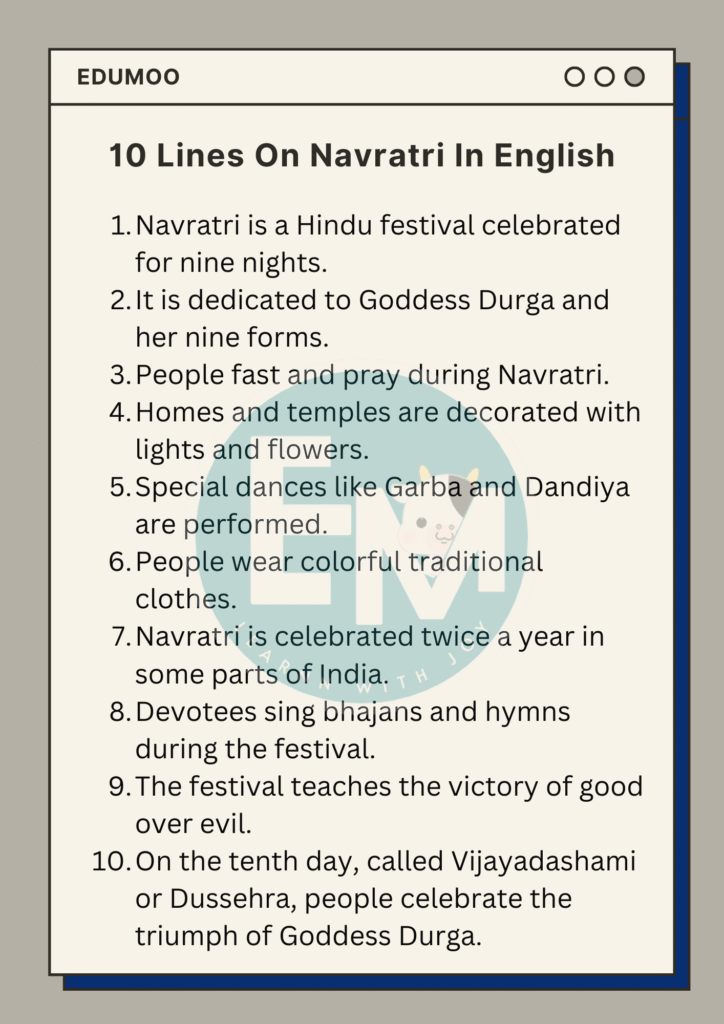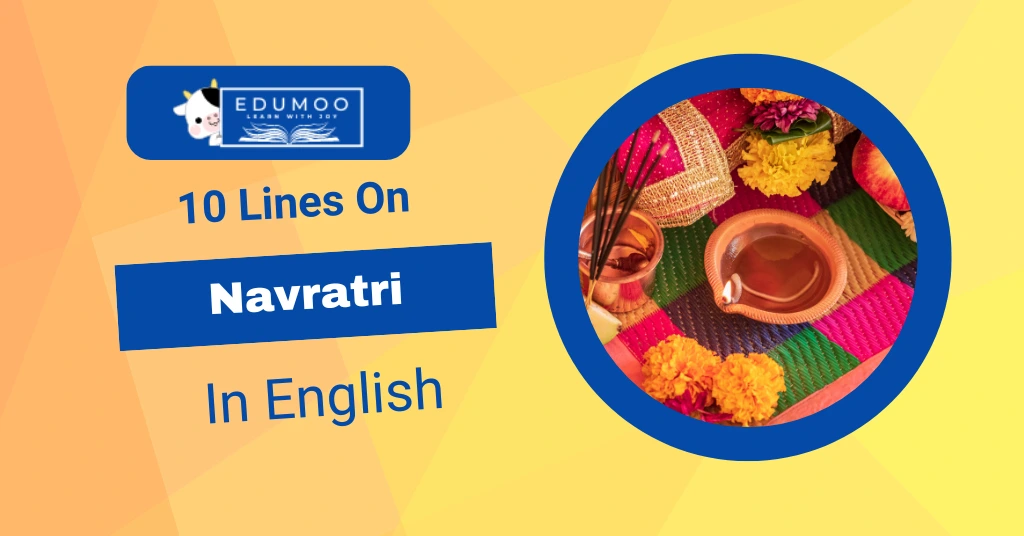Navratri is a very important Hindu festival celebrated for nine nights with great joy. During these days, people worship Goddess Durga and her nine forms with devotion. Homes and temples are decorated beautifully with flowers and lights. Devotees fast and sing prayers to please the Goddess. Special dances like Garba and Dandiya are performed, and people wear colorful traditional clothes. Navratri teaches us that good always wins over evil. The festival ends on the tenth day called Vijayadashami or Dussehra, which is celebrated with happiness and enthusiasm. It is a time for family, devotion, and fun.
10 Lines On Navratri In English
- Navratri is a Hindu festival celebrated for nine nights.
- It is dedicated to Goddess Durga and her nine forms.
- People fast and pray during Navratri.
- Homes and temples are decorated with lights and flowers.
- Special dances like Garba and Dandiya are performed.
- People wear colorful traditional clothes.
- Navratri is celebrated twice a year in some parts of India.
- Devotees sing bhajans and hymns during the festival.
- The festival teaches the victory of good over evil.
- On the tenth day, called Vijayadashami or Dussehra, people celebrate the triumph of Goddess Durga.

Essay On Navratri In English In 300 Words
Navratri is one of the most important festivals in India. It is celebrated for nine nights and ten days in honor of Goddess Durga. The word “Navratri” means nine nights. People celebrate this festival with devotion, happiness, and colorful decorations. It is believed that Goddess Durga visits her devotees during these days to bless them with happiness and prosperity.
During Navratri, people clean and decorate their homes with flowers, lights, and rangoli. Temples are also beautifully decorated, and special prayers are offered to the Goddess. Devotees follow fasting during these nine days. Some eat only fruits and milk, while others avoid certain foods. Fasting teaches patience, self-control, and respect for the Goddess.
One of the most enjoyable parts of Navratri is the traditional dances called Garba and Dandiya. People of all ages participate in these dances wearing colorful traditional clothes. Music, drums, and songs make the celebration lively and joyful. These dances are not only fun but also a way to express devotion to the Goddess.
Navratri also teaches an important lesson. It shows the victory of good over evil. On the tenth day, called Vijayadashami or Dussehra, people celebrate the triumph of Goddess Durga over the demon king Mahishasura. In many places, effigies of evil are burned to symbolize the victory of goodness.
People also share sweets and gifts with family and friends during Navratri. It is a time for unity, love, and togetherness. The festival brings families and communities closer. Navratri is celebrated with respect, fun, and devotion. It is a festival that fills everyone’s heart with joy, hope, and positive energy.
In conclusion, Navratri is a beautiful festival that combines devotion, culture, and happiness. It is not only about celebrating the Goddess but also about learning values like patience, kindness, and faith in good. Every year, people wait eagerly to celebrate Navratri with full excitement and devotion.
Essay On Navratri In English In 800 Words
Navratri is one of the most important and widely celebrated Hindu festivals in India. The word “Navratri” comes from Sanskrit, where “Nav” means nine and “Ratri” means nights. Therefore, Navratri literally means “nine nights.” It is a festival dedicated to Goddess Durga, who is worshiped in her nine different forms during these nine days. People celebrate this festival with devotion, joy, and lots of enthusiasm. It is a time when families and communities come together to offer prayers, sing devotional songs, and perform traditional dances.
The celebration of Navratri usually occurs twice a year. The most famous Navratri is during the autumn season, called Sharad Navratri, which is celebrated in the month of Ashwin (September–October). Another Navratri is during the spring season, called Chaitra Navratri, celebrated in March or April. Each day of Navratri is dedicated to one of the nine forms of Goddess Durga, such as Shailaputri, Brahmacharini, Chandraghanta, Kushmanda, Skandamata, Katyayani, Kalaratri, Mahagauri, and Siddhidatri. Devotees worship a different form each day to seek her blessings for health, happiness, knowledge, and prosperity.
During Navratri, homes and temples are decorated beautifully with flowers, lights, and rangoli. Devotees wake up early in the morning to take baths and wear clean traditional clothes. Special prayers and rituals are performed every day. People chant mantras, sing bhajans, and offer flowers, fruits, and sweets to the Goddess. Many people also follow fasting during these nine days. Some eat only fruits, milk, and dry foods, while others avoid rice, salt, or certain vegetables. Fasting teaches self-control, patience, and devotion. It is believed that fasting pleases the Goddess and brings her blessings.
One of the most popular aspects of Navratri is the traditional dances called Garba and Dandiya Raas. These dances are especially popular in Gujarat and other parts of western India. People of all ages take part in these dances wearing colorful traditional clothes. Women usually wear chaniya cholis and men wear kediyu or kurta pajamas. Music, drums, and folk songs create a lively atmosphere. Dancing is not only a way to enjoy the festival but also a form of devotion. People dance in groups around a central lamp or an image of the Goddess to show their love and respect.
Navratri also teaches an important lesson about the victory of good over evil. According to Hindu mythology, Goddess Durga fought and defeated the demon king Mahishasura after nine days of battle. The tenth day of Navratri is called Vijayadashami or Dussehra. On this day, people celebrate the triumph of good over evil. In many parts of India, large effigies of evil demons like Ravana, Kumbhkaran, and Meghanad are burned to symbolize the victory of righteousness. Children enjoy these celebrations, and families come together to watch the events.
Another important part of Navratri is community and family bonding. During this festival, people visit temples, participate in fairs, and meet friends and relatives. Many communities organize cultural programs, competitions, and exhibitions. People also exchange gifts and sweets with neighbors and friends. Navratri is not only a religious festival but also a celebration of culture and tradition. It brings people together and spreads happiness and harmony.
In addition, Navratri is celebrated in different ways across India. In West Bengal, it is celebrated as Durga Puja with grand pandals, artistic decorations, and cultural performances. In Gujarat, people mostly celebrate through Garba and Dandiya dances. In southern states like Karnataka and Tamil Nadu, dolls are arranged on steps called “Golu” to represent gods, goddesses, and mythological stories. Each region has its own special customs, but the spirit of devotion and celebration remains the same.
Food is also an important part of Navratri. During fasting, people eat special dishes made from ingredients allowed in their fast. These include fruits, milk, nuts, and flours made from buckwheat or chickpeas. Many people prepare kuttu ki puri, sabudana khichdi, and fruit salads. On the final day, people prepare feasts and share them with family members and neighbors. Sharing food is considered a way to spread love and blessings.
Navratri is also a time to reflect on life and learn important values. It teaches patience, discipline, faith, and respect for traditions. People become more mindful of their thoughts and actions during this period. It is a time to pray for the well-being of family and friends. Devotees believe that the Goddess protects them from negative energy and gives them strength to face challenges in life.
In conclusion, Navratri is a festival that combines devotion, culture, joy, and life lessons. It is celebrated with prayers, fasting, dances, music, and family gatherings. The festival reminds us that good always wins over evil and encourages people to follow a life of righteousness and faith. Navratri strengthens family bonds, brings communities together, and fills hearts with happiness and positivity. Every year, people eagerly wait for Navratri to celebrate this beautiful festival with love, devotion, and excitement.
Conclusion
Today, we have learnt 10 lines on navratri in English. Navratri is a special festival that brings joy, devotion, and happiness to everyone. It is a time to worship Goddess Durga, perform traditional dances, and celebrate with family and friends. The festival teaches important lessons about patience, discipline, and the victory of good over evil. Navratri is celebrated with colorful decorations, fasting, prayers, and music. Every day of Navratri is unique, as it honors different forms of the Goddess. The tenth day, Vijayadashami, marks the triumph of good. Navratri spreads love, unity, and positive energy. It is a festival that everyone looks forward to with excitement.

